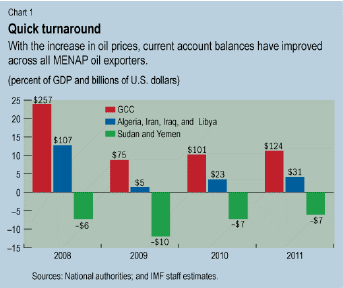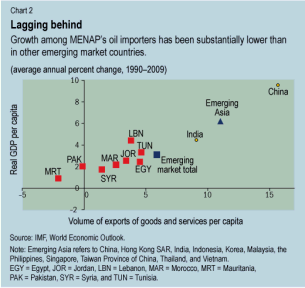Press Release: IMF Sees Growth Rebounding in Middle East and North Africa, Policy Focus to Shift to Structural Priorities
October 24, 2010
Press Release No. 10/395October 24, 2010
The Middle East and North Africa region is experiencing a generally robust recovery, aided by rising oil price and production levels and supportive fiscal policies. But the region’s oil-importing countries, in particular, continue to face some significant structural policy challenges, according to the International Monetary Fund’s (IMF) latest Regional Economic Outlook. The IMF’s report, covering the Middle East, North Africa, Afghanistan, and Pakistan (MENAP), released today in Dubai, projects the region’s output to expand by 4.2 percent in 2010, or nearly double the 2.3 percent rate recorded in 2009. Growth in 2011 is projected at 4.8 percent.
“We expect most countries in the region to grow faster in 2010 and 2011 than in 2009,” Masood Ahmed, Director of the IMF’s Middle East and Central Asia Department said. “With the economic recovery taking hold, the region needs to resume its focus on medium-term challenges: diversification and financial market development for the oil exporters, and tackling unemployment through faster, job-creating growth in the emerging markets.” Mr. Ahmed added.
Oil exporters see visible improvement
For the MENAP oil exporters—Algeria, Bahrain, Iran, Iraq, Kuwait, Libya, Oman, Qatar, Saudi Arabia, Sudan, the United Arab Emirates, and Yemen—economic activity is picking up considerably. With the rebound in worldwide demand, crude oil production is projected to grow to 25 million barrels per day (bpd) in 2010 and 26 million bpd in 2011. As a result, oil GDP will register growth rates of 3.5 percent in 2010 and 4.3 percent in 2011. The rise in oil prices—by 23 percent in 2010 and more than 3 percent in 2011—is also leading to a marked turnaround in external balances. The combined current account surplus of these countries is projected to rise by about $80 billion on current oil price expectations; of this, close to $50 billion is accounted for by the countries of the Gulf Cooperation Council (GCC) (see Chart 1).
However, the report foresees less robust non-oil activity, which the IMF estimates will pick up by only 1 percentage point between 2009 and 2011. In most countries, non-oil sector growth continues to rely on supportive fiscal policy with private financing and credit still sluggish. Unlike some other regions, capital inflows have so far shown only a small resurgence in the MEANP oil exporters.
Turning to the challenges ahead, the report recommends that, given the region’s recovery, governments strengthen their focus on the medium-term objective of promoting economic diversification and reducing the dependence of both the budget and the economy on hydrocarbons.
For the GCC, the challenge is to consolidate the gains made in the past, address any remaining vulnerabilities uncovered by the crisis, andpursue regulatory and supervisory reform in line with evolving international norms. For some other oil exporters in the region, the challenge is to spur greater financial development by removing entry and exit barriers and reducing state ownership in the banking system, the IMF report notes.
Oil importers need job-generating growth
The region’s oil importers—Afghanistan, Djibouti, Egypt, Jordan, Lebanon, Mauritania, Morocco, Pakistan, Syria, and Tunisia—have moderately strengthened in 2010, with the exception of Pakistan, which was hit by devastating floods in mid-2010. Oil importers as a whole are projected to grow 5 percent in 2010, up from 4.6 in 2009.
In view of stronger growth, the region’s governments are resuming efforts to strengthen public finances, the report notes. While public debt levels in most MENAP oil-importing countries are higher than the emerging-market average, improvements in fiscal positions in the run-up to the global crisis gave room for stimulus that limited the fallout in 2008–09. With the resumption of fiscal consolidation, government deficits are projected to narrow in 2011 in most countries, according to the report.
Nevertheless, the report recommends that for countries in the region where fiscal space is available, fiscal policy should remain expansionary through 2011. Other countries, such as Iran, Sudan, and Yemen, which have little fiscal space, are starting to appropriately withdraw fiscal stimulus and narrow deficits, it adds.
The report recommends that policymakers in MENAP’s oil-importing countries focus on the following priorities:
Raising growth to generate employment. During the past two decades, per capita growth among the oil importers has been substantially lower than in other emerging markets, mirroring a weak trade performance (see Chart 2). Faced with already high unemployment—an average of 11 percent in 2008—the challenge for the oil importers will be to raise growth to provide employment for a working age population that is growing faster than in almost all other regions. To absorb the currently unemployed and new labor market entrants over the next decade (and assuming that the ratio of jobs created to economic growth remains constant), annual growth would need to reach 6½ percent.
Enhancing competitiveness. MENAP oil importers—many of which face burdensome regulatory systems, weak institutions, and a dominating public sector—have much to accomplish to become competitive relative to other more dynamic economies. Sound macroeconomic policies—in particular, fiscal consolidation—will help support competitiveness, but governments will also need to make greater efforts to improve the business climate.
Fostering trade. The region’s trading patterns remain oriented mainly toward Europe, and there has been relatively little change in the product mix. Although there has been some diversification of trade links, the region has benefitted relatively little from the expansion of Asian and Latin American powerhouses—which contribute close to half of global GDP growth, but account for only about 9 percent of the region’s total exports.
“Enhancing MENAP’s competitiveness will be key for the region’s ability to grow faster, create more jobs and fully reap the benefits of globalization. This will imply improving the quality of education, developing a more favorable business environment, and deepening and diversifying trade flows,” Mr. Ahmed concluded.
| Selected Economic Indicators | |||||||||||||
| Middle East, North Africa, Afghanistan, and Pakistan (MENAP) | |||||||||||||
| Average | Proj. | Proj. | |||||||||||
| 2000–05 | 2006 | 2007 | 2008 | 2009 | 2010 | 2011 | |||||||
| Real GDP Growth | |||||||||||||
| (Annual change; percent) | |||||||||||||
|
MENAP |
5.1 | 5.8 | 6.0 | 4.6 | 2.3 | 4.2 | 4.8 | ||||||
|
Oil Exporters |
5.5 | 5.5 | 6.0 | 4.5 | 1.1 | 3.8 | 5.0 | ||||||
|
of Which: |
|||||||||||||
|
GCC |
5.3 | 5.6 | 5.4 | 7.0 | 0.4 | 4.5 | 5.9 | ||||||
|
Oil Importers |
4.4 | 6.3 | 6.0 | 4.9 | 4.6 | 5.0 | 4.4 | ||||||
| General Government Fiscal Balance | |||||||||||||
|
(Percent of GDP) |
|||||||||||||
|
MENAP |
2.0 | 6.8 | 5.1 | 6.4 | -3.3 | -1.9 | 0.1 | ||||||
|
Oil Exporters |
5.5 | 12.9 | 10.3 | 12.8 | -2.1 | 0.5 | 2.9 | ||||||
|
of Which: |
|||||||||||||
|
GCC |
8.9 | 22.4 | 17.4 | 25.4 | 0.3 | 4.0 | 6.9 | ||||||
|
Oil Importers |
-4.7 | -5.1 | -4.9 | -5.7 | -5.4 | -6.3 | -5.1 | ||||||
| Current Account Balance | |||||||||||||
|
(Percent of GDP) |
|||||||||||||
|
MENAP |
8.2 | 16.8 | 13.6 | 13.6 | 2.0 | 3.9 | 4.6 | ||||||
|
Oil Exporters |
11.8 | 22.9 | 18.9 | 19.5 | 4.6 | 6.7 | 7.8 | ||||||
|
of Which: |
|||||||||||||
|
GCC |
14.7 | 27.4 | 21.6 | 23.9 | 8.7 | 10.2 | 11.2 | ||||||
|
Oil Importers |
-0.4 | -1.6 | -2.4 | -4.7 | -4.4 | -3.5 | -3.6 | ||||||
|
Sources: National authorities; and IMF staff estimates and projections. |
|||||||||||||
| ||||||||||||||||||||||||||||||||||||||||||||||||||||||||||||||||||||||||||||||||||||||||||||||||||||||||||||||||||||||||||||||||||||||||||||||||||||||||||||||||||||||||||||||||||||||||||||||||||||||||||||||||||||||||||||||||||||||||||||||||||||||||||||||||||||||||||||||||||||||||||||||||||||||||||||||||||||||||||||||||||||||||||||||||||||||||||||||||||||||||||||||||||||||||||||||||||||||||||||||||||||||||||||||||||||||||||||||||||||||||||||||||||||||||||||||||||||||||||||||||||||||||||||||||||||||||||||||||||||||||||||||||||||||||||||||||||||||||||||||||||||||||||||||||||||||||||||||||||||||||||||||||||||||||||||||||||||||||||||||||||||
IMF EXTERNAL RELATIONS DEPARTMENT
| Public Affairs | Media Relations | |||
|---|---|---|---|---|
| E-mail: | publicaffairs@imf.org | E-mail: | media@imf.org | |
| Fax: | 202-623-6220 | Phone: | 202-623-7100 | |









